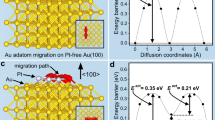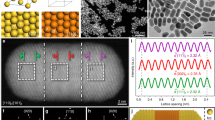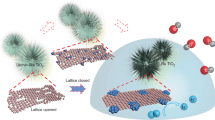Abstract
Metal nanocrystals with controlled shapes or surface structures have received increasing attention, owing to their desirable properties for applications ranging from catalysis to photonics, energy and biomedicine. Most studies, however, have been limited to nanocrystals with the same crystal phase as the bulk material. Engineering the phase of metal nanocrystals while simultaneously attaining shape-controlled synthesis has recently emerged as a new frontier of research. Here, we use Ru as an example to evaluate recent progress in the synthesis of metal nanocrystals featuring different crystal phases and well-controlled shapes. We first discuss synthetic strategies for controlling the crystal phase and shape of Ru nanocrystals, with a focus on new mechanistic insights. We then highlight the major factors that affect the packing of Ru atoms and, thus, the crystal phase, followed by an examination of the thermal stability of Ru nanocrystals in terms of both crystal phase and shape. Next, we showcase the successful implementation of these Ru nanocrystals in various catalytic applications. Finally, we end with a discussion of the challenges and opportunities in the field, including leveraging the lessons learned from Ru to engineer the crystal phase and surface structure of other metals.
This is a preview of subscription content, access via your institution
Access options
Access Nature and 54 other Nature Portfolio journals
Get Nature+, our best-value online-access subscription
$29.99 / 30 days
cancel any time
Subscribe to this journal
Receive 12 digital issues and online access to articles
$119.00 per year
only $9.92 per issue
Buy this article
- Purchase on Springer Link
- Instant access to full article PDF
Prices may be subject to local taxes which are calculated during checkout










Similar content being viewed by others
References
Xia, Y., Xiong, Y., Lim, B. & Skrabalak, S. E. Shape-controlled synthesis of metal nanocrystals: simple chemistry meets complex physics? Angew. Chem. Int. Ed. 48, 60–103 (2008).
Li, J. & Sun, S. Intermetallic nanoparticles: synthetic control and their enhanced electrocatalysis. Acc. Chem. Res. 52, 2015–2025 (2019).
Wu, J. & Yang, H. Platinum-based oxygen reduction electrocatalysts. Acc. Chem. Res. 46, 1848–1857 (2013).
Wu, Y., Wang, D. & Li, Y. Nanocrystals from solutions: catalysts. Chem. Soc. Rev. 43, 2112–2124 (2014).
Quan, Z., Wang, Y. & Fang, J. High-index faceted noble metal nanocrystals. Acc. Chem. Res. 46, 191–202 (2013).
Choi, S. I. et al. A comprehensive study of formic acid oxidation on palladium nanocrystals with different types of facets and twin defects. ChemCatChem 7, 2077–2084 (2015).
Cheng, H., Yang, N., Lu, Q., Zhang, Z. & Zhang, H. Syntheses and properties of metal nanomaterials with novel crystal phases. Adv. Mater. 30, 1707189 (2018).
Fan, Z. & Zhang, H. Crystal phase-controlled synthesis, properties and applications of noble metal nanomaterials. Chem. Soc. Rev. 45, 63–82 (2016).
Chen, Y. et al. Two-dimensional metal nanomaterials: synthesis, properties, and applications. Chem. Rev. 118, 6409–6455 (2018).
Tan, C., Chen, J., Wu, X. & Zhang, H. Epitaxial growth of hybrid nanostructures. Nat. Rev. Mater. 3, 17089 (2018).
Xu, L. & Yang, J. Size and shape-controlled synthesis of Ru nanocrystals. Phys. Sci. Rev. 3, 199–278 (2018).
Kobayashi, M., Kai, T., Takano, N. & Shiiki, K. The possibility of ferromagnetic BCC ruthenium. J. Phys. Condens. Matter. 7, 1835–1842 (1995).
Fan, Z. & Zhang, H. Template synthesis of noble metal nanocrystals with unusual crystal structures and their catalytic applications. Acc. Chem. Res. 49, 2841–2850 (2016).
Guo, Q. et al. Cubic to tetragonal phase transformation in cold-compressed Pd nanocubes. Nano Lett. 8, 972–975 (2008).
Wang, D. et al. Structurally ordered intermetallic platinum–cobalt core–shell nanoparticles with enhanced activity and stability as oxygen reduction electrocatalysts. Nat. Mater. 12, 81–87 (2013).
Huang, J. L. et al. Formation of hexagonal-close packed (HCP) rhodium as a size effect. J. Am. Chem. Soc. 139, 575–578 (2017).
Kusada, K. et al. Discovery of face-centered-cubic ruthenium nanoparticles: facile size-controlled synthesis using the chemical reduction method. J. Am. Chem. Soc. 135, 5493–5496 (2013). First report on the synthesis of Ru nanocrystals with pure fcc or hcp structures and tuneable sizes, together with the investigation of size-dependent and crystal-structure-dependent performance towards CO oxidation.
Xia, Y., Gilroy, K. D., Peng, H. C. & Xia, X. Seed-mediated growth of colloidal metal nanocrystals. Angew. Chem. Int. Ed. 56, 60–95 (2017).
Gilroy, K. D. et al. Shape-controlled synthesis of colloidal metal nanocrystals by replicating the surface atomic structure on the seed. Adv. Mater. 30, 1706312 (2018).
Fan, Z. et al. Epitaxial growth of unusual 4H hexagonal Ir, Rh, Os, Ru and Cu nanostructures on 4H Au nanoribbons. Chem. Sci. 8, 795–799 (2017).
Zhao, M. et al. Synthesis and characterization of Ru cubic nanocages with a face-centered cubic structure by templating with Pd nanocubes. Nano Lett. 16, 5310–5317 (2016). Study reporting the fabrication of Ru nanocages with both well-defined {100} facets and an fcc structure, showing promising activity towards N 2 reduction for ammonia synthesis.
Zhao, M. et al. Facile synthesis of Ru-based octahedral nanocages with ultrathin walls in a face-centered cubic structure. Chem. Mater. 29, 9227–9237 (2017).
Zhao, M. et al. Synthesis of Ru icosahedral nanocages with a face-centered-cubic structure and evaluation of their catalytic properties. ACS Catal. 8, 6948–6960 (2018).
Joo, S. H. et al. Size effect of ruthenium nanoparticles in catalytic carbon monoxide oxidation. Nano Lett. 10, 2709–2713 (2010). Study reporting the first discovery of the fcc structure in Ru nanocrystals.
Ye, H. et al. Ru nanoframes with an fcc structure and enhanced catalytic properties. Nano Lett. 16, 2812–2817 (2016). Study reporting the synthesis of Ru nanocrystals with both a frame structure and an fcc phase.
Anantharaj, S., Jayachandran, M. & Kundu, S. Unprotected and interconnected Ru0 nano-chain networks: advantages of unprotected surfaces in catalysis and electrocatalysis. Chem. Sci. 7, 3188–3205 (2016).
Rodrigues, T. S. et al. Synthesis of colloidal metal nanocrystals: a comprehensive review on the reductants. Chem. Eur. J. 24, 16944–16963 (2018).
Koenigsmann, C., Semple, D. B., Sutter, E., Tobierre, S. E. & Wong, S. S. Ambient synthesis of high-quality ruthenium nanowires and the morphology-dependent electrocatalytic performance of platinum-decorated ruthenium nanowires and nanoparticles in the methanol oxidation reaction. ACS Appl. Mater. Interfaces 5, 5518–5530 (2013).
Yin, A. X. et al. Ru nanocrystals with shape-dependent surface-enhanced Raman spectra and catalytic properties: controlled synthesis and DFT calculations. J. Am. Chem. Soc. 134, 20479–20489 (2012).
Watt, J., Yu, C., Chang, S. L. Y., Cheong, S. & Tilley, R. D. Shape control from thermodynamic growth conditions: the case of hcp ruthenium hourglass nanocrystals. J. Am. Chem. Soc. 135, 606–609 (2013).
Zheng, Y. et al. High electrocatalytic hydrogen evolution activity of an anomalous ruthenium catalyst. J. Am. Chem. Soc. 138, 16174–16181 (2016).
Poerwoprajitno, A. R. et al. Formation of branched ruthenium nanoparticles for improved electrocatalysis of oxygen evolution reaction. Small 15, 1804577 (2019).
Xia, Y., Xia, X. & Peng, H. C. Shape-controlled synthesis of colloidal metal nanocrystals: thermodynamic versus kinetic products. J. Am. Chem. Soc. 137, 7947–7966 (2015).
Vitos, L., Ruban, A. V., Skriver, H. L. & Kollár, J. The surface energy of metals. Surf. Sci. 411, 186–202 (1998).
Kumara, L. S. R. et al. Origin of the catalytic activity of face-centered-cubic ruthenium nanoparticles determined from an atomic-scale structure. Phys. Chem. Chem. Phys. 18, 30622–30629 (2016).
Song, C. et al. Size dependence of structural parameters in fcc and hcp Ru nanoparticles, revealed by Rietveld refinement analysis of high-energy X-ray diffraction data. Sci. Rep. 6, 31400 (2016).
Luo, M. & Guo, S. Strain-controlled electrocatalysis on multimetallic nanomaterials. Nat. Rev. Mater. 2, 17059 (2017).
Sneed, B. T., Young, A. P. & Tsung, C. K. Building up strain in colloidal metal nanoparticle catalysts. Nanoscale 7, 12248–45565 (2015).
Zhao, M. et al. Ru octahedral nanocrystals with a face-centered cubic structure, {111} facets, thermal stability up to 400 °C, and enhanced catalytic activity. J. Am. Chem. Soc. 141, 7028–7036 (2019). Study reporting the synthesis of {111}-enclosed Ru octahedral nanocrystals with superior thermal stability and enhanced catalytic performance.
Chen, M., Wu, B., Yang, J. & Zheng, N. Small adsorbate-assisted shape control of Pd and Pt nanocrystals. Adv. Mater. 24, 862–879 (2012).
Zheng, Y., Zeng, J., Ruditskiy, A., Liu, M. & Xia, Y. Oxidative etching and its role in manipulating the nucleation and growth of noble-metal nanocrystals. Chem. Mater. 26, 22–33 (2014).
Zhang, Z. et al. Submonolayered Ru deposited on ultrathin Pd nanosheets used for enhanced catalytic applications. Adv. Mater. 28, 10282–10286 (2016).
Yan, Y. et al. Epitaxial growth of multimetallic Pd@PtM (M = Ni, Rh, Ru) core–shell nanoplates realized by in situ-produced CO from interfacial catalytic reactions. Nano Lett. 16, 7999–8004 (2016).
Schlapka, A., Lischka, M., Groß, A., Käsberger, U. & Jakob, P. Surface strain versus substrate interaction in heteroepitaxial metal layers: Pt on Ru(0001). Phys. Rev. Lett. 91, 016101 (2003).
Strasser, P. et al. Lattice-strain control of the activity in dealloyed core–shell fuel cell catalysts. Nat. Chem. 2, 454–460 (2010).
Lu, Q. et al. Crystal phase-based epitaxial growth of hybrid noble metal nanostructures on 4H/fcc Au nanowires. Nat. Chem. 10, 456–461 (2018). Study reporting the synthesis of Ru nanocrystals crystallized in a 4H/fcc structure and showing enhanced performance towards the hydrogen evolution reaction in alkaline media.
Zhao, M. et al. Hollow metal nanocrystals with ultrathin, porous walls and well-controlled surface structures. Adv. Mater. 30, 1801956 (2018).
Lu, Q. et al. Synthesis of hierarchical 4H/fcc Ru nanotubes for highly efficient hydrogen evolution in alkaline media. Small 14, 1801090 (2018).
Wang, X., Ruditskiy, A. & Xia, Y. Rational design and synthesis of noble-metal nanoframes for catalytic and photonic applications. Natl. Sci. Rev. 3, 520–533 (2016).
Zhao, M. et al. Ruthenium nanoframes in the face-centered cubic phase: facile synthesis and their enhanced catalytic performance. ACS Nano 13, 7241–7251 (2019).
Araki, N. et al. Observation of the formation processes of hexagonal close-packed and face-centered cubic Ru nanoparticles. Chem. Lett. 48, 1062–1064 (2019).
Yao, Y. et al. Modulating fcc and hcp ruthenium on the surface of palladium–copper alloy through tunable lattice mismatch. Angew. Chem. Int. Ed. 55, 5501–5505 (2016).
Gloag, L. et al. Three-dimensional branched and faceted gold–ruthenium nanoparticles: using nanostructure to improve stability in oxygen evolution electrocatalysis. Angew. Chem. Int. Ed. 57, 10241–10245 (2018).
Gloag, L. et al. Cubic-core hexagonal-branch mechanism to synthesize bimetallic branched and faceted Pd–Ru nanoparticles for oxygen evolution reaction electrocatalysis. J. Am. Chem. Soc. 140, 12760–12764 (2018).
Chen, G., Zhang, J., Gupta, A., Rosei, F. & Ma, D. Shape-controlled synthesis of ruthenium nanocrystals and their catalytic applications. New J. Chem. 38, 1827–1833 (2014).
Nanba, Y., Ishimoto, T. & Koyama, M. Structural stability of ruthenium nanoparticles: a density functional theory study. J. Phys. Chem. C 121, 27445–27452 (2017).
Li, W. Z. et al. Chemical insights into the design and development of face-centered cubic ruthenium catalysts for Fischer–Tropsch synthesis. J. Am. Chem. Soc. 139, 2267–2276 (2017).
Mao, J. et al. Rational control of the selectivity of a ruthenium catalyst for hydrogenation of 4-nitrostyrene by strain regulation. Angew. Chem. Int. Ed. 56, 11971–11975 (2017).
Zhang, F. et al. Alkyne-functionalized ruthenium nanoparticles: impact of metal–ligand interfacial bonding interactions on the selective hydrogenation of styrene. ACS Catal. 9, 98–104 (2019).
Creus, J. et al. Ruthenium nanoparticles for catalytic water splitting. ChemSusChem 12, 2493–2514 (2019).
Tahir, M. et al. Electrocatalytic oxygen evolution reaction for energy conversion and storage: a comprehensive review. Nano Energy 37, 136–157 (2017).
Paoli, E. A. et al. Oxygen evolution on well-characterized mass-selected Ru and RuO2 nanoparticles. Chem. Sci. 6, 190–196 (2015).
Kong, X. et al. Free-standing two-dimensional Ru nanosheets with high activity toward water splitting. ACS Catal. 6, 1487–1492 (2016).
Reier, T., Oezaslan, M. & Strasser, P. Electrocatalytic oxygen evolution reaction (OER) on Ru, Ir, and Pt catalysts: a comparative study of nanoparticles and bulk materials. ACS Catal. 2, 1765–1772 (2012).
Stoerzinger, K. A. et al. The role of Ru redox in pH-dependent oxygen evolution on rutile ruthenium dioxide surfaces. Chem 2, 668–675 (2017).
Cherevko, S. et al. Oxygen and hydrogen evolution reactions on Ru, RuO2, Ir, and IrO2 thin film electrodes in acidic and alkaline electrolytes: a comparative study on activity and stability. Catal. Today 262, 170–180 (2016).
Zhao, G., Rui, K., Dou, S. & Sun, W. Heterostructures for electrochemical hydrogen evolution reaction: a review. Adv. Funct. Mater. 28, 1803291 (2018).
Vesborg, P. C. K., Seger, B. & Chorkendorff, I. B. Recent development in hydrogen evolution reaction catalysts and their practical implementation. J. Phys. Chem. Lett. 6, 951–957 (2015).
Mahmood, J. et al. An efficient and pH-universal ruthenium-based catalyst for the hydrogen evolution reaction. Nat. Nanotechnol. 12, 441–446 (2017).
Wang, J., Wei, Z., Mao, S., Li, H. & Wang, Y. Highly uniform Ru nanoparticles over N-doped carbon: pH and temperature-universal hydrogen release from water reduction. Energy Environ. Sci. 11, 800–806 (2018).
Xia, Y., Zhao, M., Wang, X. & Huo, D. Toward affordable and sustainable use of precious metals in catalysis and nanomedicine. MRS Bull. 43, 860–869 (2018).
Ohyama, J., Sato, T., Yamamoto, Y., Arai, S. & Satsuma, A. Size specifically high activity of Ru nanoparticles for hydrogen oxidation reaction in alkaline electrolyte. J. Am. Chem. Soc. 135, 8016–8021 (2013).
Gu, J. et al. Robust phase control through hetero-seeded epitaxial growth for face-centered cubic Pt@Ru nanotetrahedrons with superior hydrogen electro-oxidation activity. J. Phys. Chem. C 119, 17697–17706 (2015).
Chen, J. G. et al. Beyond fossil fuel-driven nitrogen transformations. Science 360, eaar6611 (2018).
Strait, R. Grassroots success with KAAP. Nitrogen Methanol 238, 37 (1999).
Jacobsen, C. J. H. et al. Structure sensitivity of supported ruthenium catalysts for ammonia synthesis. J. Mol. Catal. A Chem. 163, 19–26 (2000).
Foster, S. L. et al. Catalysts for nitrogen reduction to ammonia. Nat. Catal. 1, 490–500 (2018).
Andersen, S. Z. et al. A rigorous electrochemical ammonia synthesis protocol with quantitative isotope measurements. Nature 570, 504–508 (2019).
Cui, X., Tang, C. & Zhang, Q. A review of electrocatalytic reduction of dinitrogen to ammonia under ambient conditions. Adv. Energy Mater. 8, 1800369 (2018).
Zhao, P. et al. Morphology and reactivity evolution of hcp and fcc Ru nanoparticles under CO atmosphere. ACS Catal. 9, 2768–2776 (2019).
Aßmann, J. et al. Understanding the structural deactivation of ruthenium catalysts on an atomic scale under both oxidizing and reducing conditions. Angew. Chem. Int. Ed. 44, 917–920 (2005).
Qadir, K. et al. Intrinsic relation between catalytic activity of CO oxidation on Ru nanoparticles and Ru oxides uncovered with ambient pressure XPS. Nano Lett. 12, 5761–5768 (2012).
Wang, X. et al. Palladium–platinum core–shell icosahedra with substantially enhanced activity and durability towards oxygen reduction. Nat. Commun. 6, 7594 (2015).
Yang, T. H., Gilroy, K. D. & Xia, Y. Reduction rate as a quantitative knob for achieving deterministic synthesis of colloidal metal nanocrystals. Chem. Sci. 8, 6730–6749 (2017).
Wang, Y., Peng, H. C., Liu, J., Huang, C. Z. & Xia, Y. Use of reduction rate as a quantitative knob for controlling the twin structure and shape of palladium nanocrystals. Nano Lett. 15, 1445–1450 (2015).
Lyu, Z. et al. A rationally designed route to the one-pot synthesis of right bipyramidal nanocrystals of copper. Chem. Mater. 30, 6469–6477 (2018).
Duan, H. et al. Ultrathin rhodium nanosheets. Nat. Commun. 5, 3093 (2014).
Osorio-Cantillo, C., Santiago-Miranda, A. N., Perales-Perez, O. & Xin, Y. Size- and phase-controlled synthesis of cobalt nanoparticles for potential biomedical applications. J. Appl. Phys. 111, 07B324 (2012).
Fan, Z. et al. Stabilization of 4H hexagonal phase in gold nanoribbons. Nat. Commun. 6, 7684 (2015).
Acknowledgements
This work was supported, in part, by research grants from the National Science Foundation, including DMR-1505400, CHE-1505441 and CHE-1804970. It was also supported by start-up funds from the Georgia Institute of Technology.
Author information
Authors and Affiliations
Contributions
The authors contributed equally to all aspects of the article.
Corresponding author
Ethics declarations
Competing interests
The authors declare no competing interests.
Additional information
Publisher’s note
Springer Nature remains neutral with regard to jurisdictional claims in published maps and institutional affiliations.
Rights and permissions
About this article
Cite this article
Zhao, M., Xia, Y. Crystal-phase and surface-structure engineering of ruthenium nanocrystals. Nat Rev Mater 5, 440–459 (2020). https://doi.org/10.1038/s41578-020-0183-3
Accepted:
Published:
Issue Date:
DOI: https://doi.org/10.1038/s41578-020-0183-3
This article is cited by
-
Design Principles and Mechanistic Understandings of Non-Noble-Metal Bifunctional Electrocatalysts for Zinc–Air Batteries
Nano-Micro Letters (2024)
-
Advances in in situ/operando techniques for catalysis research: enhancing insights and discoveries
Surface Science and Technology (2024)
-
Automatic identification of crystal structures and interfaces via artificial-intelligence-based electron microscopy
npj Computational Materials (2023)
-
Coherent hexagonal platinum skin on nickel nanocrystals for enhanced hydrogen evolution activity
Nature Communications (2023)
-
Synthesis of amorphous Pd-based nanocatalysts for efficient alcoholysis of styrene oxide and electrochemical hydrogen evolution
Nano Research (2023)



